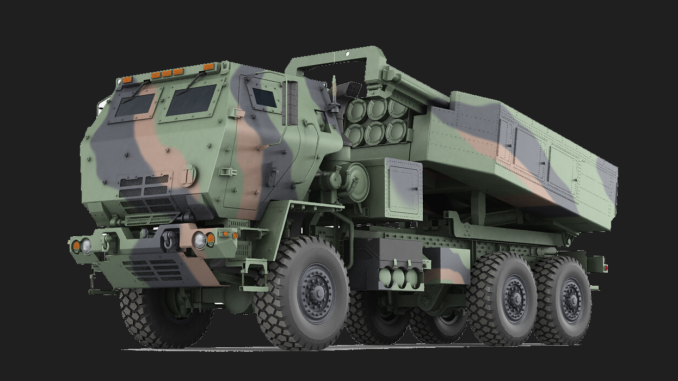
Lithuania purchase of eight HIMARS missile artillery systems is one of the essential steps in the country’s history, which will raise the country’s army to an entirely new level, according to military experts interviewed by news portal lrytas.lt, Indrė Naureckaitė writing at lrytas.lt news portal.
Lithuania’s most expensive purchase
The US announced on Thursday that it would sell eight HIMARS missile artillery systems with missiles to Lithuania for an estimated $495 million (about €493 million).
Minister of National Defence Arvydas Anušauskas pointed out that this amount is the ceiling of the US offer, so the actual price of the most expensive purchase of the Lithuanian Armed Forces so far could still change.
According to the Minister, Lithuania will contribute a part of the HIMARS acquisition funds annually and will complete the payments in 2025-2026, when the systems are expected to reach Lithuania finally. According to him, Lithuania is purchasing four types of missiles with three ranges – 15 to 92, up to 150 and up to 300 kilometres.
Now that the US administration has formally notified Congress of its decision, the legislature has 30 days to consider a possible deal with Lithuania. Anušauskas said the deal could be signed in December.
A turning point in the Lithuanian army
Defence analyst Aleksandras Matonis told lrytas.lt that the Lithuanian army has long identified the need for salvo missile systems.
“This is a weapon system that is capable of destroying enemy targets, combat equipment, objects, and live forces at a greater distance than artillery, with more powerful explosives – missiles.
However, for financial reasons, the acquisition of such weapons was only visible in the reasonably distant future. The war in Ukraine has changed many of our acquisition and combat readiness plans, which is why at the beginning of this year, the acquisition of salvo missile systems from the US started,” Matonis said.
Now, after passing through the American bureaucratic red tape, the process has moved forward, with the official permission of the US government for the sale of such systems to Lithuania and the signing of the acquisition contract soon.
“Lithuania intends to purchase eight launchers, which are trucks mounted with multi-layer systems. Each launcher can launch six missiles at a time.
It is also planned to acquire, which is extremely important, different types of missiles for different purposes. This is a breakthrough for the Lithuanian Armed Forces because we used to buy weapons with minimum ammunition, thinking we would buy more later. But there is a constant need for large quantities and variety of ammunition, and the costs are high,” the expert said.
In this case, he said, the amount of ammunition to be purchased will not only ensure the combat training of the troops who will be trained to use these missile systems but also allow them to have an emergency reserve in case they have to organise defence and combat.
Mr Matonis noted that the authorisation provides for the possibility of acquiring ultra-long-range missiles of up to 300 km.
“This is a major achievement. Although Ukraine is supplied with such missile systems, we can see that the US has not allowed Ukraine to acquire long-range munitions until now. We will have this opportunity”, he stressed.
In the meantime, the estimated cost of the HIMARS systems should not come as a surprise, according to Mr Matonis.
“This figure, approaching half a billion euros, should not come as a surprise because the purchase is accompanied by ammunition. The cost of salvo rocket artillery is not its launchers but primarily its ammunition.
Each launcher could cost a few million euros at most, but the ammunition – the missiles – makes up the whole of the deal because these are high-tech weapons,” he explained.
One of the most important steps
Aurimas Navys, a retired Special Operations Forces officer, is also convinced that this step is one of the most important in Lithuania’s history regarding national security.
“In the field of security and defence, this is probably the fifth most significant event in our country after the accession to NATO, the European Union (EU), the introduction of the euro and the deployment of the rotational battalion of the US Forces in Lithuania,” Navys said.
According to the expert, acquiring HIMARS fundamentally changes Lithuania’s combat capabilities. First of all, in terms of deterring the enemy: “HIMARS missiles have a very accurate range of 300 kilometres. It goes without saying that we can deter the enemy in the east”.
At the same time, in strategic terms, HIMARS will force Lithuania to review its defence plans and adjust them accordingly to raise them to a higher level.
“We will have to look at how we will develop our other very important capabilities to protect HIMARS. We need to understand those artillery systems are not isolated – they are a whole defence system.
When we think about how we will use those systems, we have to think immediately about how we will preserve them – intelligence, special operations, air defence and all the rest,” he stressed.
Talk of a division
Military expert retired Major Darius Antanaitis agrees that the acquisition of HIMARS will bring the Lithuanian Armed Forces to an even higher level.
“Until now, the Lithuanian Armed Forces have been able to destroy targets up to a range of 40 kilometres with self-propelled howitzers Pzh2000. However, with the HIMARS systems, the Lithuanian Armed Forces will be able to destroy targets up to 300 kilometres away from the front lines,” a retired major told lrytas.lt.
According to the expert, acquiring HIMARS will require the Lithuanian Armed Forces to move up another step and think about a division.
“Now we have to think not about two or three brigades, which we have, but about a divisional level unit. This is a large unit that can jointly carry out operations in Lithuania and abroad,” said Antanaitis.
Deterrence element
Matonis stressed that Lithuania’s unprecedented capability could force hostile states to rethink their aggressive plans.
“The enemy will have to think twice or three times twice before entering our territory because the impact of such systems is absolutely staggering in its destructive effect,” Matonis said.
The destructive power of the HIMARS systems is enormous, but the accuracy of the HIMARS missiles is also extremely high – the missiles fall where the target is, not around it.
“The effectiveness of these systems is several times greater than what our potential enemies, Russia and Belarus, have in their arsenals. Their missile systems target a large number of munitions.
Of course, its destructive power is high, but it is a morally obsolete and inaccurate, technologically backward weapon that blows up everything but does so quite inaccurately,” Matonis said.
Can we expect faster?
However, Navys hoped that HIMARS systems could be available in Lithuania sooner than currently planned by the Ministry of National Defence.
“I could only urge the diplomats and the MoD, if possible, to get it sooner and ask for the systems to be available tomorrow.
Because the Ukrainians, our brothers and sisters who are fighting for our security, are in dire need of all possible weapons, and we could give the Pzh2000 howitzers we have to the Ukrainians, who are in dire need of them.
We cannot give them away ourselves for the time being until we have replacement systems here, in this case, HIMARS. The sooner we get them from the Americans, the sooner we may be able to give the howitzers we have to the Ukrainian defenders. They must arrive as soon as possible – 2026 is a long way away,” Navys said.
At the same time, Antanaitis is reserved about the possibility of the US manufacturer Lockheed Martin producing HIMARS sooner than planned.
“One can imagine that Russia’s war against Ukraine is reducing the resources in other countries’ warehouses to a very large extent, and Lockheed Martin has received additional orders. So to expect the factory to do it faster than it can do it – I have a reserved view. However, if 2026 was mentioned, I think that is a realistic production capacity for US manufacturers,” Antanaitis said.
Mr Matonis considered that three years from the signing of the contract at the end of 2022 is a realistic timeframe for establishing HIMARS in Lithuania.
“Such weapons are not available in stores and must be made to specific orders. In this case, it will be an order from the three Baltic States.
We know that Latvia and Estonia are buying six launchers each, probably with similar conditions for munitions as ours. Still, we are buying a bit more because we have a bigger army, a bigger country and bigger needs”, Matonis explained.


Be the first to comment